

Hip Dysplasia In Dogs:
Hip Dysplasia is a condition of the hind leg in which the hip joint is badly formed. A loose joint leads to abnormal wear and in some dogs, to arthritis. Hip Dysplasia is the most common disorder of the hip in large-breed dogs.
The young dog with hip dysplasia may walk with a swaying gait, and when running may "bunny hop", moving both hind legs together. He may sit with both legs on one side and have difficulty rising. Although signs of discomfort may reduce or disappear as the dog gets older, the seeds are sown for arthritis to develop. In severe cases, this arthritis can be crippling.
Genetics: Preventing Hip Dysplasia
Hip dysplasia is not caused by one gene, but by many. A dog may carry only some of the faulty genes that produce a poor hip joint. As a result, there are many "degrees" of hip dysplasia, from a mild case with no apparent signs, through to the "sloppy" joint and very flat hip socket (where the joint is virtually absent).
Genetics: Preventing Hip Dysplasia
Hip dysplasia is not caused by one gene, but by many. A dog may carry only some of the faulty genes that produce a poor hip joint. As a result, there are many "degrees" of hip dysplasia, from a mild case with no apparent signs, through to the "sloppy" joint and very flat hip socket (where the joint is virtually absent).
Treatment Of Hip Dysplasia:
Feeding: Feeding of the young growing dog is a strong influence on whether a potentially dysplastic hip joint matures into a normal or abnormal joint. The pup that is on a high calorie diet and is rapidly increasing in size and weight is far more likely to develop dysplasia than his littermate (of the same breeding) who is brought up more slowly and who does not carry excess weight during development.
Surgery: Once hip dysplasia is evident and is causing pain or lack of use of the legsthere are several surgical procedures which may help. These are:
Feeding: Feeding of the young growing dog is a strong influence on whether a potentially dysplastic hip joint matures into a normal or abnormal joint. The pup that is on a high calorie diet and is rapidly increasing in size and weight is far more likely to develop dysplasia than his littermate (of the same breeding) who is brought up more slowly and who does not carry excess weight during development.
Surgery: Once hip dysplasia is evident and is causing pain or lack of use of the legsthere are several surgical procedures which may help. These are:
1. Removing the pectineus muscle. In some cases this seems to allow the ball of the femur to sit better in the socket of the pelvis.
2. Removal of the ball of the femur. By removing part of the femur which fits into the hip socket, the leg is left without a bony connection to the trunk. This immediately relieves pain. What then holds the leg? Hip muscles contract to firmly hold the leg in position, and a "false" joint is formed. Dogs that have had the hip joint removed usually recover to walk normally. The results are better in small breeds but good results have been obtained in dogs as large as Great Danes.
3. Remodelling the pelvis (technically, a difficult operation) by changing the architecture of the pelvis to give better seating of the joint.
2. Removal of the ball of the femur. By removing part of the femur which fits into the hip socket, the leg is left without a bony connection to the trunk. This immediately relieves pain. What then holds the leg? Hip muscles contract to firmly hold the leg in position, and a "false" joint is formed. Dogs that have had the hip joint removed usually recover to walk normally. The results are better in small breeds but good results have been obtained in dogs as large as Great Danes.
3. Remodelling the pelvis (technically, a difficult operation) by changing the architecture of the pelvis to give better seating of the joint.

Signs Of Hip Dysplasia In Your Dog:
The signs vary, and there is no way of being absolutely sure your dog has hip dysplasia unless x-rays are taken. There are signs, however, that should make you suspicious.
The signs vary, and there is no way of being absolutely sure your dog has hip dysplasia unless x-rays are taken. There are signs, however, that should make you suspicious.
4. Artificial Hips: In human medicine, total hip replacement with an artificial hip (or "prosthesis") have become a standard and highly successful procedure. Although possible in dogs, the results are variable. It is also an expensive undertaking.
Pet Meds: Dogs | Pet Meds: Cats | Dog Health : By Breed | Cat Health : By Breed | Dog Grooming | Cat Grooming | Pet Top 10's | Pet Food Recipes
Pet Meds: Dogs Pet Meds: Cats Common Dog Health Issues Common Cat Health Issues Dog Grooming Cat Grooming Pet Top 10's
Pet Health:Home
Copyright 2006-2011 PetMedsOnline.Org

Online Store For Dogs!
Find everything from basic grooming items and tasty treats, to high tech devices designed for pets!
Find everything from basic grooming items and tasty treats, to high tech devices designed for pets!
Pet Top Lists!
From the friendliest cat breeds to the most intelligent dogs, you'll find it all on our "pet top list" pages!
From the friendliest cat breeds to the most intelligent dogs, you'll find it all on our "pet top list" pages!

